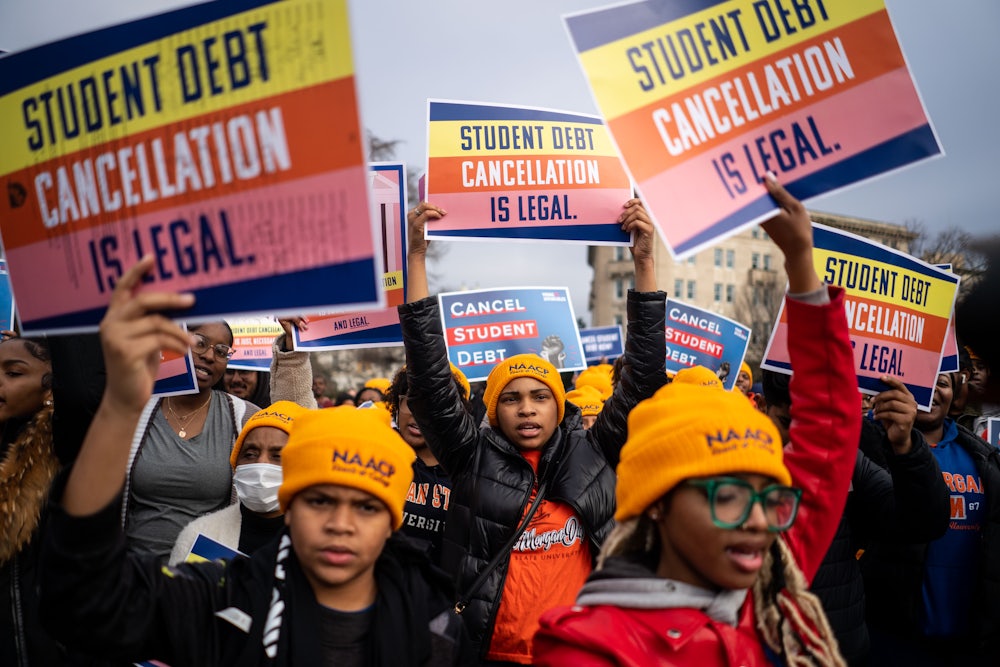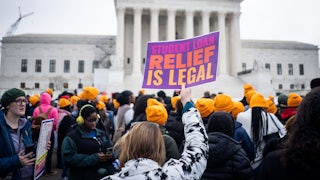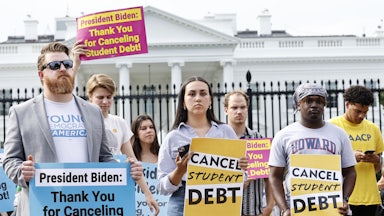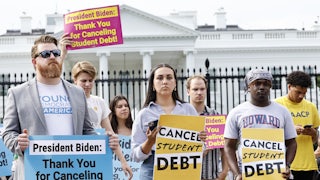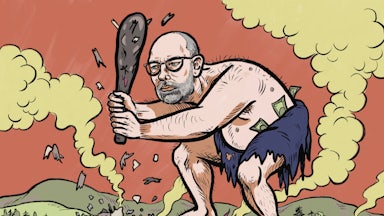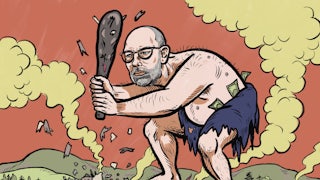The Supreme Court case over President Joe Biden’s student debt forgiveness plan sits on a throne made of lies. A new report reveals that the main argument at the heart of the lawsuit is utterly false.
Biden introduced a plan to forgive a total of $300 billion in student debt last August. The attorneys general from six Republican-led states promptly sued to block the plan, arguing primarily that Missouri’s main higher education loan organization, the Missouri Higher Education Loan Authority, or MOHELA, would suffer major financial losses if the policy were implemented. An appeals court issued a national injunction on debt relief, and then the Supreme Court took the case up directly.
Biden’s plan would forgive up to $20,000 in student debt per individual, depending on their income level and whether they had obtained a Pell Grant. The administration has cited the Heroes Act of 2003 as the law that grants it the authority; that measure permits the secretary of education to “waive or modify” student loan provisions under the circumstances of a national emergency.
Much of the debate around this case, Biden v. Nebraska, stems from the question of whether the authority provided by the Heroes Act goes so far as to grant the administration the authority to implement such sweeping loan forgiveness. Not as much attention has been paid to the question of whether the states have legal standing to bring the suit in the first place.
As it turns out, they don’t, because their underlying argument that the firm would suffer historic losses isn’t true, according to a new investigation by the Debt Collective, a debtors’ union, and the Roosevelt Institute, a liberal think tank, that was shared exclusively with The New Republic.
An internal impact analysis that MOHELA conducted in August, which the Debt Collective and Roosevelt Institute acquired through a Freedom of Information Act request, shows that the debt servicer would actually make more than $97 million annually after Biden’s student debt cancellation plan went into effect. To put that figure into context, MOHELA will make more money after the debt cancellation than at any point in its history.
But if the Supreme Court rules in favor of the states, that could have much larger consequences on all future lawsuits. “It just really speaks to the failure of the judicial process,” said Braxton Brewington, one of the report authors. “This should have never come to court, and it did make it to court and yet didn’t actually have a fair day in court.”
“It just seems like, consistently, no one is paying attention to the details or looking out on behalf of student debtors,” said Brewington, who is also the press secretary for the Debt Collective.
The lawsuit’s legal standing was shaky from the start. In order for an individual to bring a lawsuit, they typically have to prove that they have sustained or will sustain some direct harm, as well as suggest a remedy. In Biden v. Nebraska, Nebraska Solicitor General James Campbell, who argued on behalf of the states, sought to convince the justices that MOHELA is “state-controlled.” The student debt cancellation would cut MOHELA’s revenue by 40 percent, he said, preventing it from carrying out functions including making payments to the Lewis and Clark Discovery Fund, a state fund for university campus improvements.
The three liberal justices pointed out that MOHELA is, in fact, an independent entity. Even conservative Justice Amy Coney Barrett noted that the legal standing of the case would be stronger if MOHELA were there on its own.
The massive spike in revenue projected in MOHELA’s internal analysis is due to the fact that the company more than tripled the number of accounts it services over the past few years. In July, MOHELA took over the federal contract for Public Service Loan Forgiveness borrowers, which had previously been serviced out of Pennsylvania. MOHELA went from having about 2.5 million unique borrowers in 2020 to about 7.5 million by the beginning of 2023. What’s more, the internal analysis estimating massive post-debt cancellation revenue was conducted before MOHELA acquired an additional tranche of accounts.
The Debt Collective report looked at MOHELA’s financial statements that covered all new accounts and found that even if everyone who was eligible took advantage of the student loan forgiveness—which is not usually the case—MOHELA would still have nearly 5.5 million accounts. The Debt Collective report estimates conservatively that between how much MOHELA is paid to service an account (between $2 and $2.90) and how much it is paid to cancel an account (at least $11.49), the loan organization will make more than $167 million in revenue, nearly double what it made in 2022, even after student debt is forgiven. The report also found that MOHELA has not made a payment to the Lewis and Clark Discovery Fund since 2008, and its financial statements show no plans to resume paying.
None of this came to light before the Supreme Court granted the case a writ of certiorari, before the lower courts could scrutinize the case and render their own judgment. Issuing a writ of certiorari in a way that bypasses the lower court system is historically a little-used tool of the Supreme Court. However, Biden v. Nebraska marks the eighteenth such time since 2019 that the Supreme Court has interceded in this fashion. It’s a concerning shift that Stanford law professor Mark A. Lemley warned could signal that the conservative-majority court is running rampant over the other branches of government.
As Biden v. Nebraska never went through the usual appeals process, there were no opportunities to verify the facts of the case. Instead, the plaintiffs presented their claim as fact when it was argued before the Supreme Court. If the high court rules in the states’ favor, not only will the ruling be based on a lie, but it will have major ripple effects for other lawsuits going forward.
“We [would] really open up the door for all types of very dangerous claims made by people claiming to be harmed by something when they’re not,” said Brewington.
“Can someone end food stamps if they don’t qualify?” he asked hypothetically. “Can someone get rid of Medicaid if they say, ‘My private company is losing money because the government in part subsidizes food nutrition, or WIC, or health care?’”
The debt relief plan is generally popular, with a majority of Americans saying that at least some student debt should be forgiven. The plan would also primarily benefit people of color who live in less affluent areas and make less than $75,000 a year.
Economists have said that canceling student debt would boost the U.S. economy by allowing people to buy houses, invest in small businesses, and start saving for retirement. “Student loans are now contributing to what’s perceived as lower economic prospects for younger Americans,” William Foster, a vice president at credit rating business Moody’s, told NPR in 2019. It wouldn’t even need to be total forgiveness to see the broader benefits.
The question now is, what is Biden prepared to do if the Supreme Court rules against him? He announced last week that he is running for reelection. A Harvard Youth poll released last week shows he has only a 38 percent approval rating among voters under 30. Continuing to push for student debt forgiveness could be a good way to win over more younger voters.
“There’s so much at stake politically and economically,” said Brewington. “What is the executive branch going to do with this information?”
* This story originally misstated MOHELA’s projected revenue.
